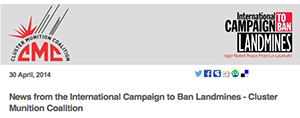21 August 2008
Georgia: Civilians Killed by Russian Cluster Bomb ‘Duds’
More Attacks Confirmed; Unexploded Ordnance Threatens Many(Tbilisi, August 21, 2008) - Georgian and Russian authorities should take urgent measures to protect the civilian population in Georgian villages from unexploded ordnance left by Russian attacks, Human Rights Watch said today. Human Rights Watch researchers documented additional Russian cluster munitions attacks during the conflict in Georgia, refuting Russia's earlier denials that it used the weapon.Human Rights Watch researchers saw and photographed unexploded submunitions from cluster munitions in and around the villages of Shindisi, in the Gori district of Georgia. Residents from Shindisi and the nearby Pkhvenisi village told Human Rights Watch researchers there are hundreds of unexploded submunitions in the area. Submunition "duds"are highly dangerous and can explode if picked up or otherwise disturbed."Many people have died because of Russia's use of cluster munitions in Georgia, even as Moscow denied it had used this barbaric weapon,"said Marc Garlasco, senior military analyst at Human Rights Watch. "Many more people could be killed or wounded unless Russia allows professional demining organizations to enter at once to clean the affected areas."Witnesses told Human Rights Watch that on August 8, 2008, Russian air strikes on Georgian armored units located near Shindisi and Pkhvenisi were followed by extensive cluster munition strikes that killed at least one civilian and injured another in Shindisi. At least two more civilians were killed and five wounded in the following days when they handled unexploded submunitions, including an incident 10 days after the initial strikes. As of August 20, Shindisi and Pkhvenisi areas remain under Russian control.Human Rights Watch called upon Russia to immediately stop using cluster munitions, weapons so dangerous to civilians that more than 100 nations have agreed to ban their use. Human Rights Watch also called on Russia to provide precise strike data on its cluster attacks in order to facilitate cleanup of areas contaminated by submunitions. Human Rights Watch called on Georgia to undertake an immediate risk education program for its population, including radio and television announcements about the dangers of submunitions.In Shindisi, Human Rights Watch researchers saw unexploded dual purpose (anti-armor and antipersonnel) submunitions, commonly known as Dual-Purpose Improved Conventional Munition (DPICM) submunitions."Highly dangerous unexploded bomblets now litter farms, roads, and pathways in Shindisi and Pkhvenisi,"said Garlasco. "People remaining in these areas don't realize the dangers these submunitions pose and are at serious risk of injury or death if they handle, or even approach, the bomblets."Human Rights Watch first reported on Russian use of cluster munitions in Georgia on August 15, after it identified strikes on Gori and Ruisi on August 12 that killed at least 11 civilians and injured dozens more (http://hrw.org/english/docs/2008/08/14/georgi19625.htm). Russia subsequently denied any use of cluster munitions. Colonel General Anatoly Nogovitsyn, deputy head of the Russian General Staff, stated on August 15, "We did not use cluster bombs, and what's more, there was absolutely no necessity to do so."Zura Tatrishvili, 62, showed Human Rights Watch researchers an unexploded submunition that he had picked up without realizing that just touching it could make it explode. "We were playing with them, as were the Georgian soldiers,"said Tatrishvili. "It was only when one of the bombs exploded after a soldier threw it that we understood that they were dangerous."Even now, Tatrishvili continues to keep his livestock in a pen with unexploded submunitions, demonstrating the need for clearance as well as education.During the attack on August 8 in Shindisi, Vano Gogidze, 45, was killed and his relative, Dato Gogidze, 39, was injured. Also in Shindisi, Ramaz Arabashvili, 40, was killed and four people were wounded when a submunition that they had gathered from a field exploded on August 10. On August 18, in Pkhvenisi, Veliko Bedianashvili, 70, died when a submunition exploded in his hand. "There are so many of these lying around. The fields are full of them,"said his son, Durmiskhan Bedianashvili.Zviad Geladze, 38, showed Human Rights Watch researchers fields contaminated with submunitions. He estimated the submunitions covered an area extending at least one kilometer through his farm. The fields are full of produce ready to harvest. Because humanitarian agencies continue to lack access to much of the Gori region, fields like Geladze's may provide residents of the region with their only food source.Cluster munitions contain dozens or hundreds of smaller submunitions or bomblets and cause unacceptable humanitarian harm in two ways. First, their broad-area effect kills and injures civilians indiscriminately during strikes. Second, many submunitions do not explode, becoming de facto landmines that cause civilian casualties for months or years to come.Under international humanitarian law, indiscriminate attacks including attacks in populated areas with weapons that cannot be targeted solely at military targets are prohibited. Russia has an obligation not only to cease any such attacks, but also to take all necessary measures now to ensure the safety of the civilian population in areas over which it exercises effective control.Human Rights Watch called on Georgia, which is known to have cluster munitions in its stockpiles, to join the international move to ban the use of cluster munitions and to publicly undertake not to use such weapons in this conflict. Neither Russia nor Georgia was part of the Oslo Process launched in February 2007 to develop a new international treaty banning cluster munitions. In May 2008, 107 nations adopted the Convention on Cluster Munitions, which comprehensively bans the use, production, trade and stockpiling of the weapon (http://hrw.org/english/docs/2008/05/30/18976.htm). It will be open for signature in Oslo on December 3.For background on Russia's use of cluster munitions, please see:http://hrw.org/english/docs/2008/08/14/russia19624.htm For more of Human Rights Watch's work on cluster munitions, please visit:http://www.hrw.org/doc/?t=arms_clusterbombs


